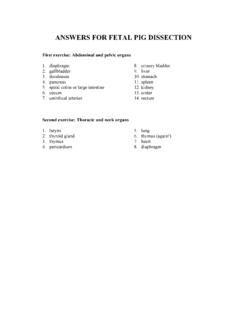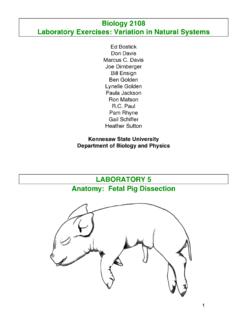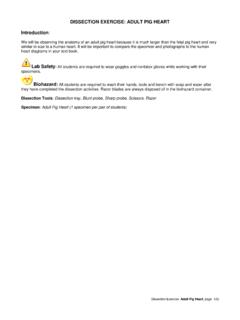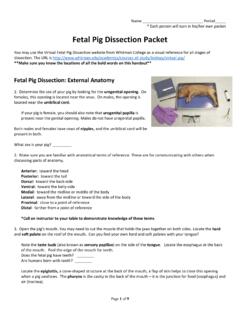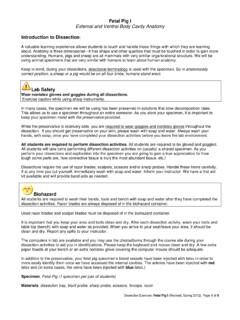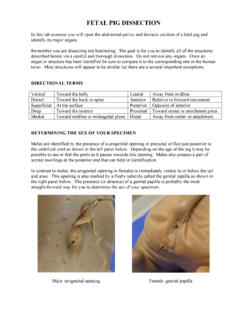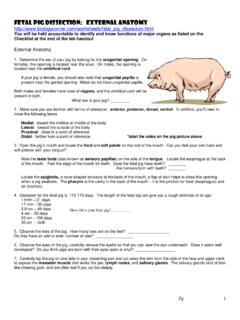Transcription of B29 Fetal Pig Dissection - mendozascience.com
1 HOLT BIOSOURCESLab Program: Inquiry Skills B29137 Fetal Pig DissectionSkills using Dissection instruments and techniquesObjectives Describe the appearance of various organs found in a Fetal pig. Name the organs that make up various systems of a Fetal safety goggles, gloves, and a lab apron scalpel preserved Fetal pig probe dissecting tray and paper towels dissecting needle length of string forceps plastic storage bag and twist tie scissors marking pen dissecting pins (10) WARD safePurposeIn this lab, you will study the external and internal anatomy of a Fetal pig, relateits structures to those of other mammals, and determine differences between afetal pig and an adult body shape of the pig is closely related to its method of locomotion.
2 It hasbilateral body is composed of four regions a head, neck, trunk, trunk, which has two pairs ofappendages,can be subdivided intothethorax and the head contains two eyes, eyelids,and the snout area contains thenares (nostrils) and the legs are similar to those of many other four-legged mammals. On each leg,the digits combine to form a hoof is cloven,that is, it is divided intotwo parts at the end. The pig actually walks on the tips of its remains of the umbilical cordare also present.
3 In the male, an externalpouch, the scrotal sac,is located between the upper parts of the hind sac contains forelimb consists of an upper arm, forearm, is locatedbetween the hand and the forearm. The elbow protrudes on the posterior side ofthe junction of the forelimb with the body. The shoulderis not recognized byany obvious feature. Each hind limb consists of a thigh,aleg,and a foot is similar to the forefoot. The ankleprotrudes on the posterior side ofthe leg. The hip(or upper part of the thigh) is a bony mass close to the internal anatomy is similar to that of other mammals, including organs of the digestive, respiratory, excretory, circulatory, nervous, andreproductive systems are much the _____Date _____ Class _____HRW material copyrighted under notice appearing earlier in this SKILLSLAB PROGRAMHRW material copyrighted under notice appearing earlier in this BIOSOURCESLab Program.
4 Inquiry Skills B29 Significant differences of the Fetal pig compared to the adult pig and digestive system are not path of blood involves the umbilical cord. Blood is oxygenated by themother, with oxygen transferred from the mother s blood to the Fetal blood oxygenated blood is carried from the placenta back to thefetus by one vein in the umbilical cord. Then the blood passes mainly into thevena cavas and on to the heart. The deoxygenated blood is carried in twoarteries in the umbilical cord back to the heart has a ductus Fetal life, blood circulates throughthe heart somewhat as in the adult, with the exception of the ductus arterio-sus.
5 This shunt reroutes deoxygenated blood from the pulmonary arteries tothe on the age of the fetus, testes may not yet have fully descended intothe scrotal bladderis an elongated sac between two umbilical arteriesandone umbilical veinin the umbilical 1 External Anatomy of the Fetal on safety goggles, gloves, and a lab necessary, turn the specimen in the dissecting tray, as shown in the diagrambelow. Use this diagram to help you locate and identify the external featuresof the Fetal pig, including the head, neck, trunk.
6 And tail N Q U I R Y S K I L L S B 2 9 c o n t i n u e d Head regionEarEyelidsSnoutNostrilTongueMouthU pper armForearmHandShoulderAnkleHind limbFootDigit toesUmbilical cordUmbilicalarteriesUmbilicalveinElbowT eatsKneeAppendagesTailForelimbWristThora xAbdomenHipThighLegNeckregionTrunk regionTail regionEyeHRW material copyrighted under notice appearing earlier in this BIOSOURCESLab Program: Inquiry Skills the eyes, eyelids, ears, and nares in the head the thoracic and abdominal regions of the the thick, threadlike body hair (or bristles).
7 The animal ventral side up as shown in the diagram below. Locatethe teats (nipples of the mammary glands) and the umbilical scissors, cut the umbilical cord near where it joins the abdominal wall. Inthe umbilical cord, locate the two umbilical arteries and the one umbilical to locate the scrotal sac between the hind legs. The sac may or may notcontain the fully descended testes. The presence or absence of the scrotal saccan be used to determine the sex of your the urogenital opening. In the male, the opening releases both spermand urine from the body.
8 In the female, the urogenital opening is locatedimmediately ventral to the anus, the external opening of the rectum. Theanus is ventral to the tail. Lift the tail to locate the the hoof, hand, wrist, forearm, upper arm, and shoulder of a the hoof, foot, ankle, leg, and thigh of a hind will not be able to complete the Dissection in one lab before the end of the period, your teacher will have you stopyour Dissection . Place the animal on its back in the dissecting tray. Tie a stringaround one forelimb; bring the string under the tray to fasten back the otherforelimb.
9 Use another string to spread apart the hind limbs in the same the specimen attached to the Dissection tray, wrap the specimen inpaper towels or cloth containing WARD safe. Store the specimen in a plasticbag, close it with a twist tie, and use a felt-tip marking pen to write yourname on the bag. Clean up your work area and wash your hands before leaving the N Q U I R Y S K I L L S B 2 9 c o n t i n u e d Teats (nipples)Umbilical cordUrogenital openingGenital tubercleScrotal sacMaleFemaleHRW material copyrighted under notice appearing earlier in this BIOSOURCESLab Program: Inquiry Skills B29 Part 2 Internal Anatomy of the Fetal open the mouth with a probe.
10 Using scissors, cut through the jointbetween the upper and lower jaws to aid in your the oral, or mouth, cavity find the tongue. The teeth have usually the pharynx, the mouth cavity that begins at the jaw hinges andextends to the esophagus. In the pharynx, try to locate the glottis (the open-ing of the trachea) and the Eustachian tubes, which extend from the pharynxto the middle ear. Then locate the esophagus in the back of the the diagram below, which shows where incisions, numbered insequence, should be made.
